HiSilicon Kirin 960: A Closer Look at Performance and Power
by Matt Humrick on March 14, 2017 7:00 AM EST- Posted in
- Smartphones
- Mobile
- SoCs
- HiSilicon
- Cortex A73
- Kirin 960
Memory Performance
ARM made several improvements to the A73’s memory system. Both L1 caches see an increase in size, with the I-cache growing from 48KB (A72) to 64KB and the D-cache doubling in size to 64KB. The A73 includes several other changes, such as enhanced prefetching, that should improve cache performance too.
The A73 still has 2 AGUs like the A72, but they are now capable of both load and store operations instead of having each AGU dedicated to a single operation like in the A72, which should improve the issue rate into main system memory.
The Kirin 960’s larger 64KB L1 cache maintains a steady latency of 1.27ns versus 1.74ns for the Kirin 950, a 27% improvement that far exceeds the 2.6% difference in CPU frequency, highlighting the A73’s L1 cache improvements. L2 cache latency is essentially the same, but Kirin 960 again shows a 27% latency improvement over Kirin 950 when accessing main memory, which should be beneficial for the latency sensitive CPUs.
Memory bandwidth results are less definitive, however. The Kirin 960 shows up to a 30% improvement in L1 read bandwidth over the Kirin 950 depending on the access pattern used, although L1 write bandwidth is lower by nearly the same amount. The 960’s L2 cache bandwidth is also lower for both read and write by up to about 30%.
The two graphs above, which show reading and writing NEON instructions using two threads, help to illustrate Kirin 960’s memory bandwidth. When reading instructions, Kirin 960’s L1 cache outperforms the 950’s, but bandwidth drops once it hits the L2 cache. The Kirin 950 outpaces the 960 when writing to both L1 and L2, only falling below the 960’s bandwidth when writing to system memory. This reduction in cache bandwidth could help explain the Kirin 960’s performance regression in several of Geekbench 4’s floating-point tests.
| Geekbench 4 - Memory Performance Single Threaded |
||||
| Kirin 960 | Kirin 950 (% Advantage) |
Exynos 7420 (% Advantage) |
Snapdragon 821 (% Advantage) |
|
| Memory Copy | 4.55 GB/s | 3.67 GB/s (23.87%) |
3.61 GB/s (26.04%) |
7.82 GB/s (-41.84%) |
| Memory Latency | 12.1 Mops/s | 9.6 Mops/s (25.39%) |
5.6 Mops/s (115.67%) |
6.6 Mops/s (81.82%) |
| Memory Bandwidth | 15.5 GB/s | 9.2 GB/s (69.28%) |
7.5 GB/s (105.84%) |
13.5 GB/s (14.53%) |
While the Kirin 960’s L1/L2 cache performance is mixed, it holds a clear advantage over the Kirin 950 when using system memory. Memory latency improves by 25%, about the same amount our internal testing shows, and memory bandwidth improves by 69%. The A73’s two load/store AGUs are likely responsible for a large chunk of the additional memory bandwidth, with the Mate 9’s higher memory bus frequency helping some too.
System Performance
Now it’s time to see how Kirin 960’s lower-level CPU and memory results translate into real-world performance, keeping in mind that OEMs can influence the balance between performance and battery life in a number of ways, including adjusting thermal limits and parameters that govern CPU scheduler and DVFS behavior, which is one reason why two devices with the same SoC can perform differently.
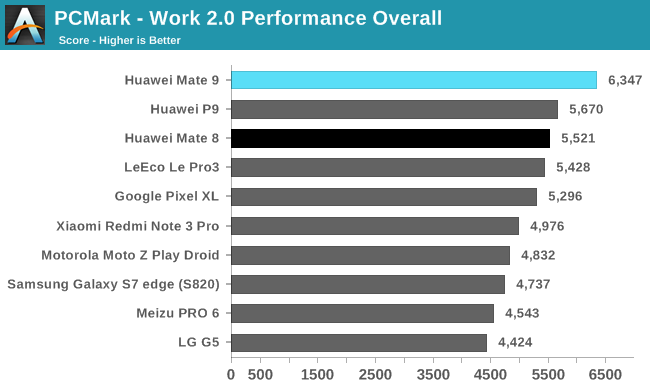
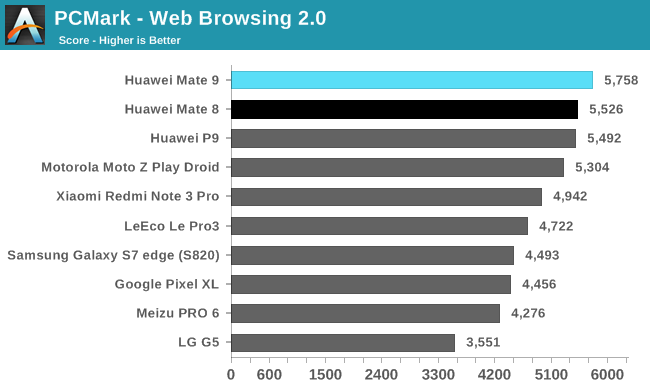
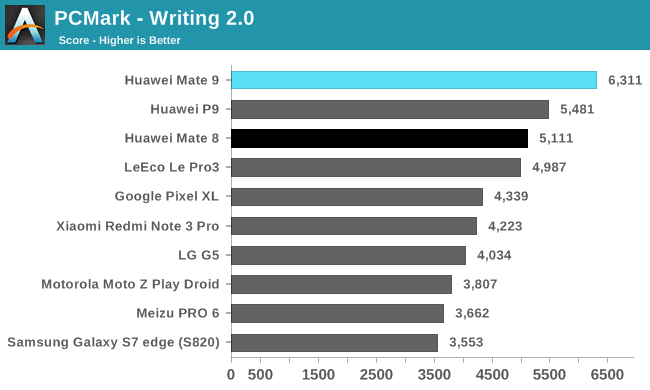
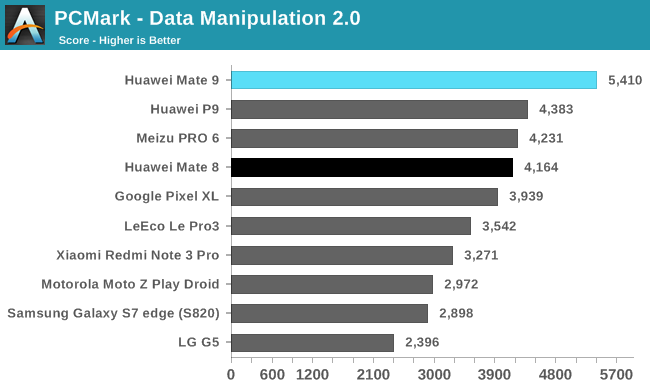
PCMark includes several realistic workloads that stress the CPU, GPU, RAM, and NAND storage using Android API calls many common apps use. The Mate 9 and its Kirin 960 SoC land at the top of each chart, outpacing the Mate 8 and its Kirin 950 by 15% overall and the top-performing Snapdragon 821 phones by up to 20%.
The Mate 9’s advantage over the Mate 8 is only 4% in the Web Browsing test, but it’s still the fastest phone we’ve tested so far. Integer performance is not the Kryo CPU’s strength, and in this integer-heavy test all of the Snapdragon 820/821 phones fall behind SoCs using ARM’s A72 and A73 CPUs, with LeEco’s Le Pro3, the highest performing Snapdragon 821 phone, finishing 18% slower than the Mate 9.
The Writing test performs a variety of operations, including PDF processing and file encryption (both integer workloads), along with some memory operations and even reading and writing some files to internal NAND, and it tends to generate frequent, short bursts of activity on the big CPU cores. This seems to suit the Mate 9 just fine, because it extends its performance advantage over the Mate 8 to 23%. There’s a pretty big spread between the Snapdragon 820/821 phones; the LeEco Le Pro3, the best performer in the family, is 40% faster than the Galaxy S7 edge, a prime example of how other hardware components and OEM software tinkering can affect the overall user experience.
The Data Manipulation test is another primarily integer workload that measures how long it takes to parse chunks of data from several different file types and then records the frame rate while interacting with dynamic charts. In this test, the Mate 9 is 30% faster than the Mate 8 and 37% faster than the Pixel XL.
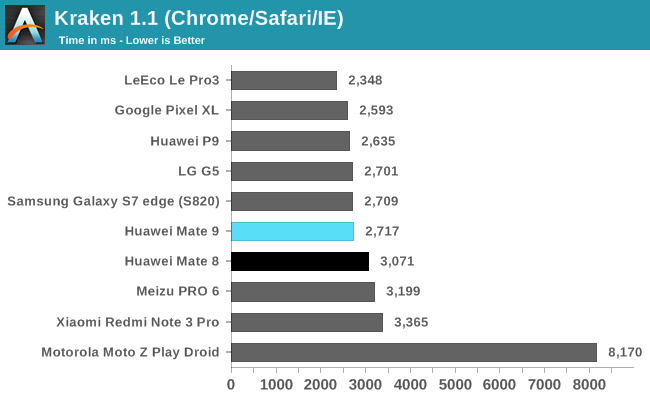
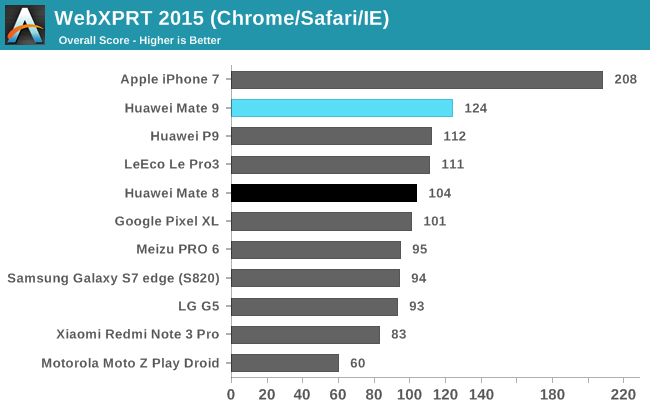
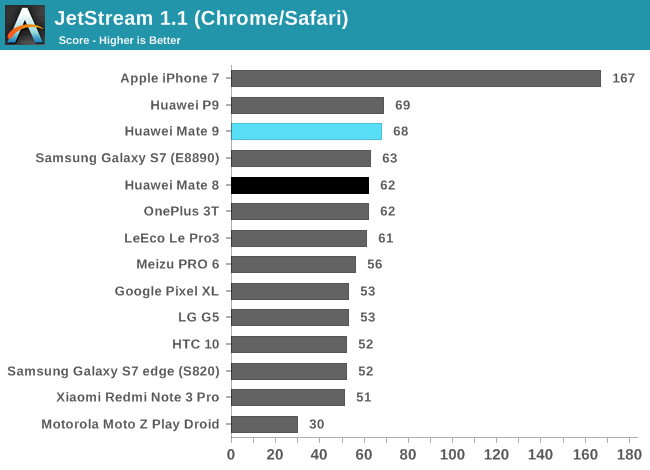
All of the Snapdragon 820/821 phones perform well in the Kraken JavaScript test, pulling ahead of the Mate 9 by a small margin. The P9 uses Kirin 955’s 7% CPU frequency advantage to help it keep up with the Mate 9 in Kraken and JetStream. The Mate 9 still pulls ahead by 11% in WebXPRT 2015, though, and outperforms the Mate 8 by 10% to 19% in all three tests. The Moto Z Play Droid, the only phone in the charts to use an octa-core A53 CPU configuration, cannot even manage half the performance of the Mate 9, which is similar to what our integer IPC tests show.
The Kirin 960 showed mixed results in our lower-level CPU and memory testing, pulling ahead of the Kirin 950 in some areas while falling behind in others. But when looking at system level tests using real-world workloads, the Mate 9 and its Kirin 960 are the clear winners. There are many hardware and software layers between you and the SoC, which is why it’s important not to use an SoC benchmark to test system performance and a system benchmark, such as PCMark, to test CPU performance.


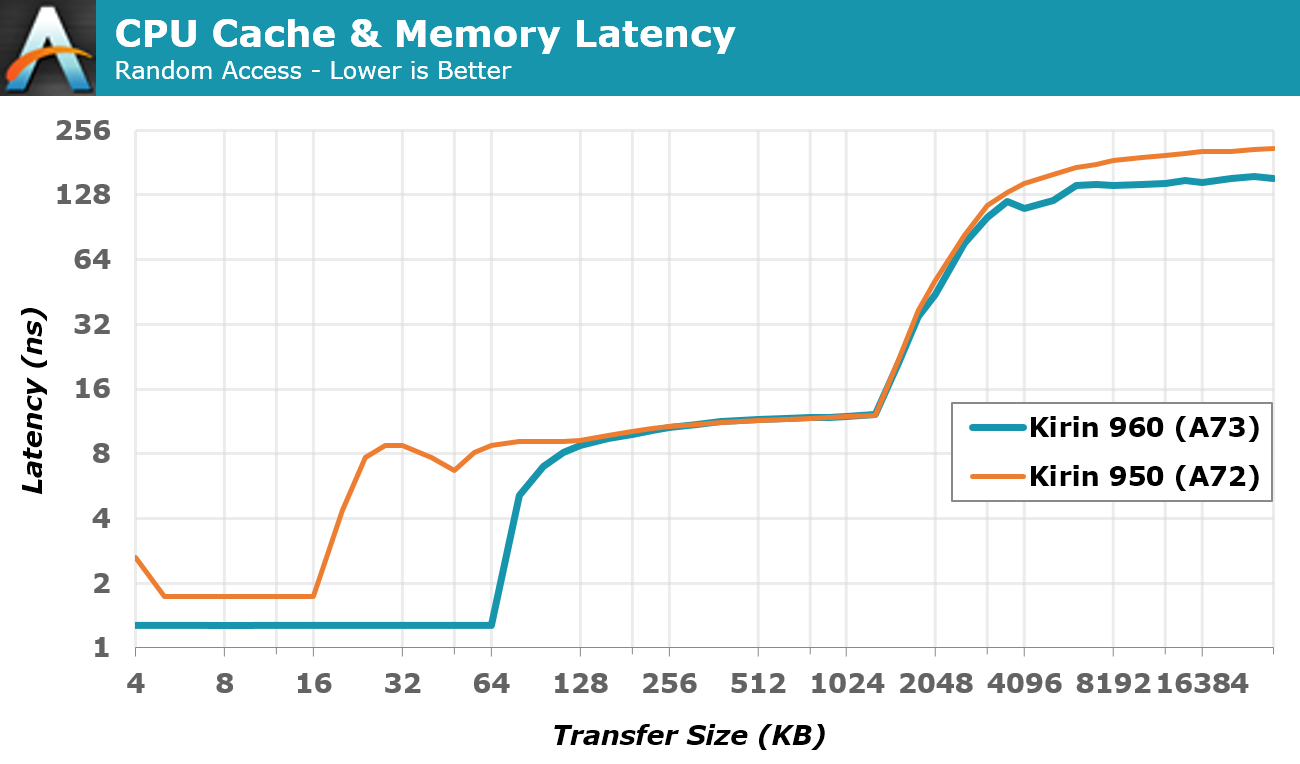
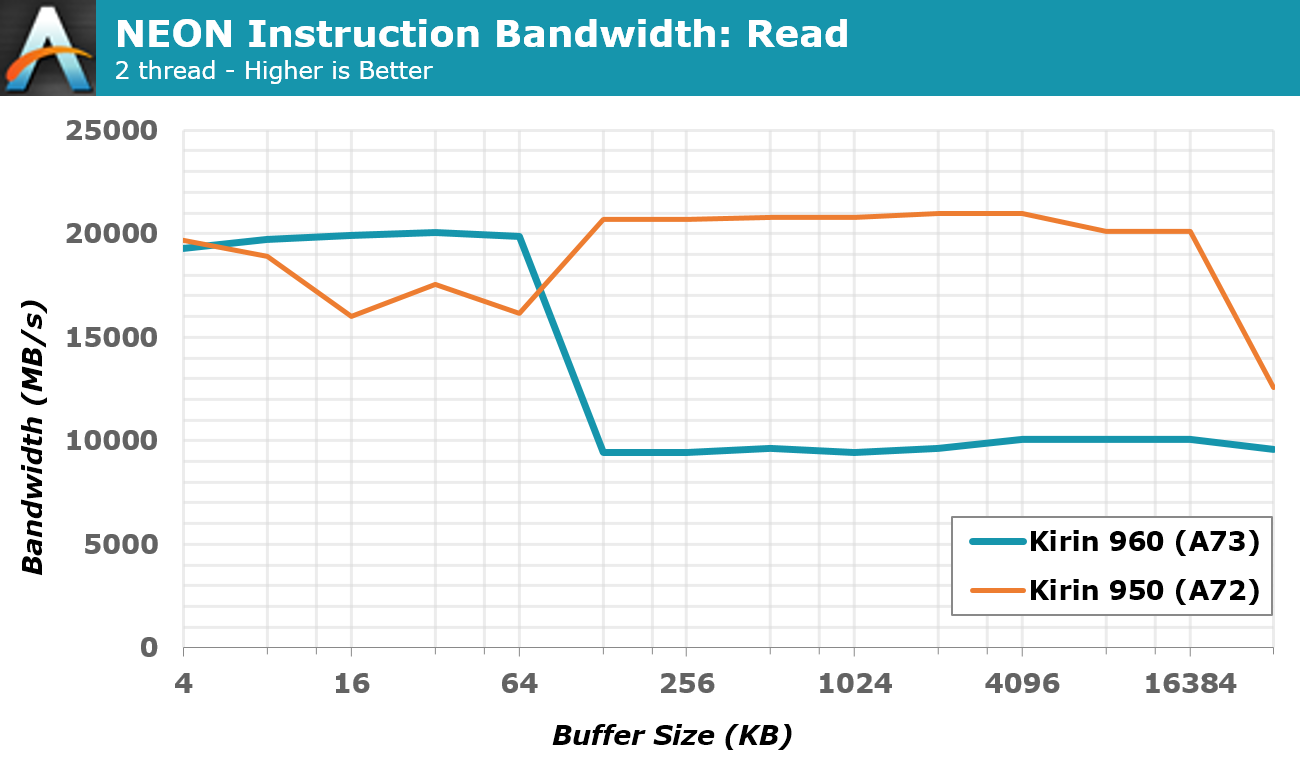









86 Comments
View All Comments
hans_ober - Tuesday, March 14, 2017 - link
A10 deepdive?Araa - Tuesday, March 14, 2017 - link
Thats the smell of a dead elephant in the room.MrSpadge - Tuesday, March 14, 2017 - link
Wrong thread, this one is about Kirin 960.niva - Tuesday, March 14, 2017 - link
Well I for one am glad to see this deepdive into the performance. It gives a much more complete picture of what's happening. People on Android Central were giving this chip such glowing reviews and I really wasn't sold on it yet. That being said I'm fairly confident AC is sponsored by Huawei because any phone they push out gets glowing reviews despite it's Chinese hackware. Only Huawei phone worth buying is the Nexus 6P and still remains so. This won't change even if/when they actually do make better hardware.close - Tuesday, March 14, 2017 - link
"Only Huawei phone worth buying is the Nexus 6P [...]. This won't change even if/when they actually do make better hardware."So you "know" that even if they make better hardware only the 6P will be worth buying? Crystal ball much? Are you also sponsored by somebody or did you just choose ignorance? And I'm being delicate here.
BertrandsBox - Tuesday, March 14, 2017 - link
"Only Huawei phone worth buying is the Nexus 6P and still remains so. This won't change even if/when they actually do make better hardware."If Android Central gets accused of hiding sponsorship from Huawei, do silly comments like these make you someone who's being paid by Huawei's competitors?
Alexvrb - Tuesday, March 14, 2017 - link
A lot of reviewers take free bread. Especially ones that aren't making enough off ads alone, or that have a personal slant, etc. I'm not saying that includes AC, but you shouldn't dismiss it so casually either. The most effective place to apply grease is reviewers and review sites. The Kirin 960 is obviously a step sideways, so to give it glowing reviews is hilarious.However... even though the process and design they chose may be hindering power consumption at these clocks, they did have another goal in mind. Cost. If they really achieved such massive increases in density, and have a similar % yield, they can sell bucketloads of these chips for cheap. So at least for the mid-range devices, these would be plenty good for the foreseeable future.
close - Wednesday, March 15, 2017 - link
A lot of internet commentators are paid to praise one sine or company and accuse competing ones. This is an undisputed fact so you shouldn't dismiss this casually.The point wasn't whether AC is or isn't on Huawei's payroll but rather the attitude of the person commenting who basically disqualified themselves by saying that "even with better products they will never be worth buying".That sound like the user doesn't actually care about the product or the facts, and is only here to criticize Huawei and anything that might be related to them.
And no matter what he says in the future none of it can be taken seriously and contain any trace of objective value ;).
fanofanand - Wednesday, March 15, 2017 - link
Where does one go to cash in on the whole "paid internet commenting" bit? I'd like some of that "internet money" please :)Meteor2 - Wednesday, March 15, 2017 - link
Yeah me too